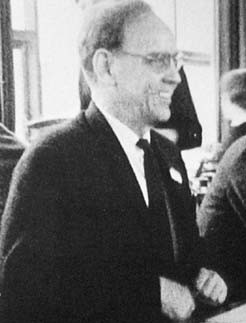-
(b.) -1912 March 02(d.)1982 October 14
Bio/Description
A topologist known for his work in point-set topology and also for his contributions in category theory, sheaf theory and knot theory, he was brought up on a small farm in Western Ontario, Canada. He excelled in mathematics and was paid to teach his math teacher math at his secondary school. He was awarded a scholarship at Western Ontario University, where he got his B.S. in 1933. He wanted to pursue a career as a teacher, but he was persuaded to continue with his education because of his extraordinary mathematical talent. He earned his Ph.D. from Princeton University in 1938. After earning his doctorate, he became an instructor at the Western Ontario University for a year. The next year, he worked as an assistant back at Princeton under John von Neumann. During World War II, he worked for the U.S. Air Force, calculating the trajectories of projectiles. After the war, he was appointed associate professor at the Tufts University. Because of Senator Joseph McCarthy's red scare, he decided to take his family to England shortly thereafter, where he was appointed Reader in applied mathematics at Birkbeck University in 1951. In 1962 he was granted a personal chair, until he retired in 1979. He showed that Čech and Vietoris homology groups coincide, as do the Čech cohomology and Alexander cohomology groups. He, along with Morwen Thistlethwaite, developed Dowker notation, a simple way of describing knots, suitable for computers The last years of his life were marked by a long illness, yet he continued working, developing Dowker notation in the weeks before his death in 1983; publishing a joint paper, ?Classification Of Knot Projections? with Morwen B. Thistlethwaite. The authors describe their results as follows: ?The first step in tabulating the noncomposite knots with n crossings is the tabulation of the nonsingular plane projections of such knots, where two (piecewise linear) projections are regarded as equivalent, or in the same class, if they agree up to homeomorphism of the extended plane, i.e., the two-sphere. This first step is here reduced to a simple algorithm suitable for computer use.? Although a mathematical genius, he remained modest, with a gentle humor, to the end of his days. He and his wife were dedicated to their work with children, particularly with gifted children who were having difficulties at school. They undertook this work for the National Association for Gifted Children. He was able to give these children what any mathematician will recognize as an incredibly wonderful experience, namely the experience of discovering new mathematical results.
-
Date of Birth:
1912 March 02 -
Date of Death:
1982 October 14 -
Gender:
Male -
Noted For:
Developer of the Dowker notation; a simple way of describing knots, suitable for computers -
Category of Achievement:
-
More Info:


